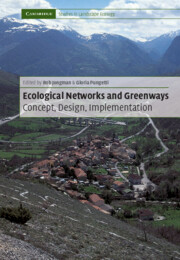Book contents
- Frontmatter
- Contents
- List of contributors
- Foreword
- Preface
- Acknowledgements
- 1 Introduction: ecological networks and greenways
- 2 The context and concept of ecological networks
- 3 Greenways in the USA: theory, trends and prospects
- 4 Ecological functioning of ecological networks: a species perspective
- 5 Impacts of roads on ecological networks and integration of conservation and transportation planning: Florida as a case study
- 6 Ecological corridors on a European scale: a typology and identification of target species
- 7 Planning the future landscape between nature and culture
- 8 From models to reality: design and implementation process
- 9 Design of the Pan-European Ecological Network: a national level attempt
- 10 Ecological ‘black spots’ within the ecological network: an improved design for rural road network amelioration
- 11 An ecological network for the Milan region based on focal species
- 12 Connecting corridors: implementing metropolitan greenway networks in North America
- 13 The Florida Statewide Greenways Project: its realisation and political context
- 14 The ecological network development in the Yungas, Argentina: planning, economic and social aspects
- 15 The river corridor of the Guadiamar
- 16 Conclusions: into the twenty-first century
- References
- Index
Preface
Published online by Cambridge University Press: 29 December 2009
- Frontmatter
- Contents
- List of contributors
- Foreword
- Preface
- Acknowledgements
- 1 Introduction: ecological networks and greenways
- 2 The context and concept of ecological networks
- 3 Greenways in the USA: theory, trends and prospects
- 4 Ecological functioning of ecological networks: a species perspective
- 5 Impacts of roads on ecological networks and integration of conservation and transportation planning: Florida as a case study
- 6 Ecological corridors on a European scale: a typology and identification of target species
- 7 Planning the future landscape between nature and culture
- 8 From models to reality: design and implementation process
- 9 Design of the Pan-European Ecological Network: a national level attempt
- 10 Ecological ‘black spots’ within the ecological network: an improved design for rural road network amelioration
- 11 An ecological network for the Milan region based on focal species
- 12 Connecting corridors: implementing metropolitan greenway networks in North America
- 13 The Florida Statewide Greenways Project: its realisation and political context
- 14 The ecological network development in the Yungas, Argentina: planning, economic and social aspects
- 15 The river corridor of the Guadiamar
- 16 Conclusions: into the twenty-first century
- References
- Index
Summary
MacArthur and Wilson's theory was and to a large extent remains a radical departure from mainstream thinking in contemporary community ecology. In its fundamental assumption it is a neutral theory that asserts that island communities are dispersal assembled and not niche assembled.
This statement was made in 2001 by Stephen Hubbell in his ‘unified neutral theory of biodiversity and biogeography’ (Hubbell 2002). He continues on metapopulation perspectives, asserting that this theory is very well applicable in cases of habitat fragmentation. Despite some critical discussion in scientific journals, the theory found application in planning and did change attitudes to nature conservation. The wider countryside has slowly been included in nature conservation, as also has landscape planning and land use planning.
In 1987 the President's Commission on Americans Outdoors in the United States of America recommended the ‘greenways’ as new tools ‘to provide people with access to open spaces close to where they live, and to link together the rural and urban spaces in the American landscape’ (President's Commission 1987).
At the international conference ‘Conserving Europe's Natural Heritage: Towards a European Ecological Network’ held in Maastricht in 1993, Graham Bennett envisaged the need for an operational framework for guiding the implementation of strategies on European nature conservation, indicating the concept of ‘ecological network’ as a tool for this (Bennett, 1994a). Engendered by the need to conserve and enhance the functioning of the ecological infrastructure of a region, the concept quickly moved on to conserving biological and landscape diversity, and to assisting other policy sectors with responsibility for sustainability and the conservation of natural ecosystems and biodiversity.
- Type
- Chapter
- Information
- Ecological Networks and GreenwaysConcept, Design, Implementation, pp. xvii - xixPublisher: Cambridge University PressPrint publication year: 2004

